When Artificial Intelligence Tools Meet “Non-Violent” Learning Environments (SDG 4.3): Crossroads with Smart Education
Abstract
:1. Introduction
1.1. Bibliometric Analysis
- Number of articles—3625.
- Field of knowledge—all branches.
- Publication type—all types.
- Publication period—2019–2023 (2023 data as of the date of access to the Scopus database).
- Total number of topic clusters generated by SciVal—476.
- The keyword “non-violent” relates to education and SDG 4. The search results show the presence of about 20 clusters related to education topics.
- The maximum value of the popularity percentile for the studied clusters is 80, and the minimum is 15. Popular clusters are devoted to various aspects of the student-teacher relationship. The cluster percentile values and the increase in percentiles show that the topic of non-violent learning environments is gaining popularity.
- About ten query “non-violent” clusters are related to artificial intelligence. However, the study of artificial intelligence is limited only to the technical component (methods, tools, and software). It does not focus on the ideological component (the role of AI in students’ lives).
- In the clusters, there are no traces of assessing students’ opinions regarding the characteristics of a non-violent learning environment. Thus, studying the students’ opinions regarding the non-violent learning environment is necessary.
- Among the clusters for the request “non-violent” are those associated with student development in the educational field. This fact indicates the need for additional study of the role of AI in the non-violent learning environment and its prospects.
- Clusters on the request “non-violent”, which are related to educational topics, study this problem mainly in the field of knowledge “Social sciences”. This fact emphasizes the importance of the ideological (not technical) component of the relationship between AI and stakeholders in the educational process.
1.2. Construct Review
- The first concern may be the potential loss of personal interaction between university teachers and learners. Students may fear that automated learning systems may limit opportunities for communication, sharing ideas, and learning soft skills, which are also crucial in shaping education.
- The automation of certain aspects of teaching may cause job losses for teachers, especially in routine tasks, which may entail the need for new skills and adaptation to the professional community. However, as the author’s research shows [59], students do not consider this option as likely over the next five years.
- “Matthew effect”. If access to AI tools is uneven, students from less affluent backgrounds or regions may face additional challenges. This may create a digital divide where some students have more significant opportunities to use high-tech educational resources than other students, resulting in the failure to meet the requirements of other SDGs, such as SDG 4.5.
1.3. Connection: “Smart Education (Approach)–AI (Technical Tools)–Student (Stakeholder)–Survey (Feedback Tool)”
- -
- -
- -
- -
- -
1.4. Summarizing
- Some important definitions of our manuscript are:
- 1.1
- “Non-Violent” learning environments are an educational space where students can freely express their thoughts, ideas, and feelings without fear of being subjected to physical or emotional violence (SDG 4.3).
- 1.2
- Smart education provides personalized learning using AI anywhere, anytime.
- 1.3
- Artificial intelligence tools for teachers are software programs and platforms that use artificial intelligence technologies to enhance the teaching and learning experience.
- “Non-violent” learning environments (SDG 4.3) may be considered together with e-learning, smart education, and AI tools. Students’ achievements, i.e., learners, are the ultimate goal of smart education [34,38]. Smart education and AI tools are associated with each other [34,37,41,42,43,44,45,49,50,51,52,53,54].
- AI and its capabilities in the smart education concept are the subject of technical research and the search for optimal software solutions. Assessing the attitudes of stakeholders (learners) towards AI is essential to optimizing the interaction between AI and stakeholders (learners).
- Introducing AI tools in educational services has created gaps for global pedagogical theory and practice. Studying the attitudes of stakeholders (learners) towards AI will enrich global pedagogical theory and practice in verifying the requirements of a “non-violent” learning environment (SDG 4.3).
- “Non-violent” learning environments may be considered together with e-learning, smart education, SDG 4.3, and AI tools.
- (1)
- Some students do not meet the “non-violent” learning environment requirements.
- (2)
- The number of these students can be up to 31.94%.
- These two statistically substantiated new scientific facts are helpful for generalization, comprehension, and further development of world pedagogical theory and practice.
- Under the guidance of experienced managers, managerial actions aimed at SDG 4.3 should be developed to ensure “non-violent” learning environments.
2. Materials and Methods
2.1. Common Description
- Study and analysis of scientific sources and documents for building a theoretical framework for the research;
- Bibliometric multi-step analysis;
- Questioning of students using an electronic questionnaire hosted in the Cloud of National Louis University as an empirical part of the research on SDG 4.3 (sustainability in higher education);
- Formal processing and graphical visualization of questioning results based on standard tools;
- Verification of statistical hypotheses through standard tools.
2.2. Questioning of Students
- Definitely positively;
- Rather positively;
- Hard to say;
- Rather negatively;
- Definitely negatively.
2.3. Respondent Groups
2.4. Methodology of Verification of Statistical Hypotheses
3. Results
3.1. Analysis of Answers to the Question: How Do You Feel about Using Artificial Intelligence in the Teaching Process?
3.2. Verification of Statistical Hypotheses: The Number of Students with a Negative Attitude towards Using AI in the Teaching Process Is Zero
4. Discussion
- Personalized learning experiences.
- 2.
- Automated grading and feedback.
- 3.
- Democratization of education.
- 4.
- Ethical considerations and data privacy.
- 5.
- Balancing technology and human interaction.
- 6.
- Preparing students for the future.
5. Conclusions
- -
- Some students do not meet the requirements of “non-violent” learning environments.
- -
- The number of these students can be up to 31.94%.
Author Contributions
Funding
Institutional Review Board Statement
Informed Consent Statement
Data Availability Statement
Acknowledgments
Conflicts of Interest
References
- Parusheva, S.; Bobek, S.; Zabukovšek, S.S. Sustainable Higher Education: From E-Learning to Smart Education. Sustainability 2023, 15, 10378. [Google Scholar] [CrossRef]
- Sharma, B.K.; Kumar, V.V.R.; Bhatt, V.K. Factors Influencing E-learning Technology Among Youth in India: An Extended TAM Model. Manag. Labour Stud. 2023, 49, 504–526. [Google Scholar] [CrossRef]
- Monib, W.K. Afghan Undergraduate Students’ Perceptions Toward E-learning. E-Learn. Digit. Media 2023. [Google Scholar] [CrossRef]
- Ismail, A.; Ismail, A.; Alazar, A.; Saman, M.; Abu-Elqomboz, A.; Sharaf, F.K. E-Learning Medical Education in Gaza During COVID-19: Students’ Experiences and Policy Recommendations. J. Med. Educ. Curric. Dev. 2023, 10. [Google Scholar] [CrossRef] [PubMed]
- Mensah, M.S.; Arthur, K.N.; Mensah-Williams, E. Antecedents of E-learning in Undergraduate Entrepreneurship Education. E-Learn. Digit. Media 2023, 21, 496–516. [Google Scholar] [CrossRef]
- Gurban, M.A.; Almogren, A.S. Students’ Actual Use of E-Learning in Higher Education During the COVID-19 Pandemic. SAGE Open 2022, 12. [Google Scholar] [CrossRef]
- Durrani, N.; Ozawa, V. Education in Emergencies: Mapping the Global Education Research Landscape in the Context of the COVID-19 Crisis. Sage Open 2024, 14. [Google Scholar] [CrossRef]
- Ceesay, L.B. Learning Beyond the Brick and Mortar: Prospects, Challenges, and Bibliometric Review of E-learning Innovation. Jindal J. Bus. Res. 2021, 10, 33–48. [Google Scholar] [CrossRef]
- Lee, K.-T.; Duncan-Howell, J. How Do We Know E-Learning Works? Or Does it? E-Learn. Digit. Media 2007, 4, 482–496. [Google Scholar] [CrossRef]
- Moy, F.M.; Ng, Y.H. Perception towards E-learning and COVID-19 on the mental health status of university students in Malaysia. Sci. Prog. 2021, 104. [Google Scholar] [CrossRef]
- Wang, Y.; Liu, X.; Zhang, Z. An Overview of E-learning in China: History, Challenges and Opportunities. Res. Comp. Int. Educ. 2018, 13, 195–210. [Google Scholar] [CrossRef]
- Sakamoto, T. E-Learning in Japanese Universities. Ind. High. Educ. 2003, 17, 397–404. [Google Scholar] [CrossRef]
- Kumar, A. E-Learning: A Tool for Education in Rural India. Asia Pac. Bus. Rev. 2007, 3, 113–122. [Google Scholar] [CrossRef]
- Aljaber, A. E-learning Policy in Saudi Arabia: Challenges and Successes. Res. Comp. Int. Educ. 2018, 13, 176–194. [Google Scholar] [CrossRef]
- De Vliegher, K.; Paquay, L.; Cordyn, S.; Heirstrate, L.; Goense, E.; Pechon, S.; Labalue, J.; Putzeys, D. Home Nurses’ Opinions Toward E-Learning in Continuing Education. Home Health Care Manag. Pract. 2015, 27, 216–223. [Google Scholar] [CrossRef]
- Alonso-Díaz, L.; Yuste-Tosina, R. Constructing a Grounded Theory of E-Learning Assessment. J. Educ. Comput. Res. 2015, 53, 315–344. [Google Scholar] [CrossRef]
- Mutisya, D.N.; Makokha, G.L. Challenges Affecting Adoption of E-learning in Public Universities in Kenya. E-Learn. Digit. Media 2016, 13, 140–157. [Google Scholar] [CrossRef]
- Ansong, E.; Lovia Boateng, S.; Boateng, R. Determinants of E-Learning Adoption in Universities: Evidence From a Developing Country. J. Educ. Technol. Syst. 2017, 46, 30–60. [Google Scholar] [CrossRef]
- Costarides, M.V. Knowledge Management and E-Learning. Health Promot. Pract. 2014, 15, 790–794. [Google Scholar] [CrossRef]
- Murphy, E.; Rodríguez-Manzanares, M.A. High School Teachers’ Beliefs about Learner-Centred E-Learning. E-Learn. Digit. Media 2008, 5, 384–395. [Google Scholar] [CrossRef]
- Okulich-Kazarin, V.; Artyukhov, A.; Skowron, Ł.; Artyukhova, N.; Wołowiec, T. Will AI Become a Threat to Higher Education Sustainability? A Study of Students’ Views. Sustainability 2024, 16, 4596. [Google Scholar] [CrossRef]
- Sui, C.; Xie, Y. The Effect of Smart Campus on the Low Infection Rate in the Post-pandemic Era. Sci. Prog. 2023, 106. [Google Scholar] [CrossRef] [PubMed]
- Phoong, S.Y.; Phoong, S.W.; Moghavvemi, S.; Sulaiman, A. Effect of Smart Classroom on Student Achievement at Higher Education. J. Educ. Technol. Syst. 2019, 48, 291–304. [Google Scholar] [CrossRef]
- Huang, T.-C. Antistray, Learning Smart: Creating Indoor Positioning Learning Environment for Augmenting Self-Regulated Learning. Int. J. Distrib. Sens. Netw. 2014, 10, 427675. [Google Scholar] [CrossRef]
- Aguilar, J.; Cordero, J.; Buendía, O. Specification of the Autonomic Cycles of Learning Analytic Tasks for a Smart Classroom. J. Educ. Comput. Res. 2018, 56, 866–891. [Google Scholar] [CrossRef]
- Kang, Z.; Palma Fraga, R.; Izzoteglu, K.; Lee, J.; Deering, D.D.; Arana, W.X. Development of a Smart Learning Application in Multi-person Virtual Reality Using Biometric Measures of Neuroimaging, Eye Tracking, and Haptic Interactions. Proc. Hum. Factors Ergon. Soc. Annu. Meet. 2023, 67, 2137–2143. [Google Scholar] [CrossRef]
- Ha, I.; Kim, C. The Research Trends and the Effectiveness of Smart Learning. Int. J. Distrib. Sens. Netw. 2014, 10, 537346. [Google Scholar] [CrossRef]
- Adarkwah, M.A.; Odame, J.; Huang, R.; Wang, H.; Amoako, P.Y.O. Smart teaching versus hard teaching: Insights from instructors from old and new classrooms in Ghana. E-Learn. Digit. Media 2024, 20427530241251412. [Google Scholar] [CrossRef]
- Wang, Y.; Eysink, T.H.S.; Qu, Z.; Yang, Z.; Shan, H.; Zhang, N.; Zhang, H.; Wang, Y. Interactive Response System to Promote Active Learning in Intelligent Learning Environments. J. Educ. Comput. Res. 2022, 60, 1867–1891. [Google Scholar] [CrossRef]
- Steehler, A.J.; Pettitt-Schieber, B.; Alexander, P.A. The Smart Use of Smart Technologies in Teaching and Learning: Where We Are and Where We Need to Be. Ear Nose Throat J. 2022, 101 (Suppl. S9), 29S–36S. [Google Scholar] [CrossRef]
- Mechling, L.C.; Gast, D.L.; Thompson, K.L. Comparison of the Effects of Smart Board Technology and Flash Card Instruction on Sight Word Recognition and Observational Learning. J. Spec. Educ. Technol. 2008, 23, 34–46. [Google Scholar] [CrossRef]
- Lee, J.-S.; Kim, S.-W. Validation of a Tool Evaluating Educational Apps for Smart Education. J. Educ. Comput. Res. 2015, 52, 435–450. [Google Scholar] [CrossRef]
- Uskov, V. Smart Education: Students’ Perception of Hybrid Learning in Graduate Computing Curriculum. In Smart Innovation, Systems and Technologies; Uskov, V.L., Howlett, R.J., Jain, L.C., Eds.; KES-SEEL 2023; Smart Education and e-Learning—Smart University; Springer: Singapore, 2023; Volume 355. [Google Scholar] [CrossRef]
- Demir, K.A. Smart Education Framework. Smart Learn. Env. 2021, 8, 29. [Google Scholar] [CrossRef]
- Kaur, M.; Bhatia, M. Smart Education: A Systematic Survey and Future Research Directions. In Proceedings of the 2021 International Conference on Computing Sciences (ICCS), Phagwara, India, 4–5 December 2021; pp. 173–177. [Google Scholar] [CrossRef]
- Bordel, B.; Mareca, P. New Teaching and Learning Methodologies in the Smart Higher Education Era, A Study Case, Wikipedia. Int. J. Technol. Hum. Interact. 2019, 15, 70–83. [Google Scholar] [CrossRef]
- Lynch, J.; Redpath, T. ‘Smart’ technologies in early years literacy education: A meta-narrative of paradigmatic tensions in iPad use in an Australian preparatory classroom. J. Early Child. Lit. 2014, 14, 147–174. [Google Scholar] [CrossRef]
- Zhu, Z.; Yu, M.-H.; Riezebos, P. A Research Framework of Smart Education. Smart Learn. Environ. 2016, 3, 1. [Google Scholar] [CrossRef]
- Jang, S. Study on Service Models of Digital Textbooks in Cloud Computing Environment for SMART Education. International J. U- E-Serv. Sci. Technol. 2014, 7, 73–82. [Google Scholar] [CrossRef]
- Olthouse, J.M. Multiliteracies Theory and Gifted Education: Creating “Smart Spaces” in the Language Arts Classroom. Gift. Child Today 2013, 36, 246–253. [Google Scholar] [CrossRef]
- El Janati, S.; Maach, A.; El Ghanami, D. SMART Education Framework for Adaptation Content Presentation. Procedia Comput. Sci. 2018, 127, 436–443. [Google Scholar] [CrossRef]
- Watkins, S.E.; Konz, B.A.; Dua, R.; Belarbi, A.; Wunsch, D.C. Smart Truss for Education. J. Intell. Mater. Syst. Struct. 2011, 22, 317–326. [Google Scholar] [CrossRef]
- Sunitha, M.; Vijitha, B.; Gunavardhan, E. Artificial Intelligence based Smart Education System. In Proceedings of the 2023 4th International Conference on Electronics and Sustainable Communication Systems (ICESC), Coimbatore, India, 6–8 July 2023; pp. 1346–1350. [Google Scholar] [CrossRef]
- Sudharson, K.; Arvindan, R.R.; Balashunmugham, M. A Survey on AR-Based Digitization for Smart Education System. In Proceedings of the 2023 IEEE International Students’ Conference on Electrical, Electronics and Computer Science (SCEECS), Bhopal, India, 18–19 February 2023; pp. 1–5. [Google Scholar] [CrossRef]
- Mohanachandran, D.K.; Yap, C.T.; Ismaili, Z.; Govindarajo, N.S. Smart University and Artificial Intelligence. In The Fourth Industrial Revolution: Implementation of Artificial Intelligence for Growing Business Success. Studies in Computational Intelligence; Hamdan, A., Hassanien, A.E., Razzaque, A., Alareeni, B., Eds.; Springer: Cham, Switzerland, 2021; Volume 935. [Google Scholar] [CrossRef]
- Yunus, N.; Nasir Ismail, M.; Osman, G. Smart library themes and elements: A systematic literature review. J. Librariansh. Inf. Sci. 2023. [Google Scholar] [CrossRef]
- Yi, S.; Yun, R.; Duan, X.; Lu, Y. Similar or Different? A Comparison of Traditional Classroom and Smart Classroom’s Teaching Behavior in China. J. Educ. Technol. Syst. 2021, 49, 461–486. [Google Scholar] [CrossRef]
- Tripon, C.; Gonța, I.; Bulgac, A. Nurturing Minds and Sustainability: An Exploration of Educational Interactions and Their Impact on Student Well-Being and Assessment in a Sustainable University. Sustainability 2023, 15, 9349. [Google Scholar] [CrossRef]
- Krumm, A.; Means, B.; Bienkowski, M. Learning Analytics Goes to School: A Collaborative Approach to Improving Education; Routledge: Oxford, UK, 2018. [Google Scholar]
- Yunjiu, L.; Wei, W.; Zheng, Y. Artificial Intelligence-Generated and Human Expert-Designed Vocabulary Tests: A Comparative Study. SAGE Open 2022, 12. [Google Scholar] [CrossRef]
- Fischer, C.; Pardos, Z.A.; Baker, R.S.; Williams, J.J.; Smyth, P.; Yu, R.; Slater, S.; Baker, R.; Warschauer, M. Mining Big Data in Education: Affordances and Challenges. Rev. Res. Educ. 2020, 44, 130–160. [Google Scholar] [CrossRef]
- Akçapınar, G.; Altun, A.; Aşkar, P. Using Learning Analytics to Develop Early-Warning Systems for At-Risk Students. International Journal of Educational Technology in Higher Education 2019, 16, 40. [Google Scholar] [CrossRef]
- Scarlatos, A. Editorial Overview: Special Issue on Artificial Intelligence in Education. J. Educ. Technol. Syst. 2024, 52, 299–300. [Google Scholar] [CrossRef]
- Lazendic, G.; Justus, J.-A.; Rabinowitz, S. NAPLAN Online Automated Scoring Research Program: Research Report; Australian Curriculum, Assessment, and Reporting Authority: Sydney, NSW, Australia, 2018. [Google Scholar]
- Onopriienko, I.; Onopriienko, K.; Bourekkadi, S. Immersive Technologies in Adult Learning as an Innovative Marketing Tool in the Educational Market. Bus. Ethics Leadersh. 2023, 7, 63–72. [Google Scholar] [CrossRef]
- Drost, B.R.; Levine, A.C. The Alternative Narrative: When Digital Learning Worked During the Pandemic. J. Educ. 2024. [Google Scholar] [CrossRef]
- Yoshimori, H.; Yoshimori, M. An Education Gift—Integrated Cognitive and Non-Cognitive Skills—For Future Generations to Grow the Economy in the Digital Phase. Socio Economic Chall. 2022, 6, 5–18. [Google Scholar] [CrossRef]
- Managheb, S.; Zamani, A.; Shams, B.; Farajzadegan, Z. The effect of communication skills training by video feedback method on clinical skills of interns of Isfahan University of medical sciences compared to didactic methods. Health Educ. J. 2012, 71, 546–552. [Google Scholar] [CrossRef]
- Okulich-Kazarin, V.; Artyukhov, A.; Skowron, Ł.; Artyukhova, N.; Dluhopolskyi, O.; Cwynar, W. Sustainability of Higher Education: Study of Student Opinions about the Possibility of Replacing Teachers with AI Technologies. Sustainability 2024, 16, 55. [Google Scholar] [CrossRef]
- Xiaoling, P.; Xuan, Z. The Transformation of Artificial Intelligence in the 5G Era and the Impact on Education. In 2022 IEEE 2nd International Conference on Electronic Technology, Communication and Information (ICETCI); IEEE: Changchun, China, 2022; pp. 903–907. [Google Scholar] [CrossRef]
- Ghnemat, R.; Shaout, A.; Al-Sowi, A.M. Higher Education Transformation for Artificial Intelligence Revolution: Transformation Framework. Int. J. Emerg. Technol. Learn. (Ijet) 2022, 17, 224–241. [Google Scholar] [CrossRef]
- Humin Yang, M. Anbarasan, and Thanjai Vadivel. Knowledge-Based Recommender System Using Artificial Intelligence for Smart Education. J. Interconnect. Netw. 2022, 22 (Supp. S2), 2143031. [Google Scholar] [CrossRef]
- Zhang, X.; Chen, L. College English Smart Classroom Teaching Model Based on Artificial Intelligence Technology in Mobile Information Systems. Mob. Inf. Syst. 2021, 2021, 5644604. [Google Scholar] [CrossRef]
- Bajaj, R.; Sharma, V. Smart Education with Artificial Intelligence-Based Determination of Learning Styles. Procedia Comput. Sci. 2018, 132, 834–842. [Google Scholar] [CrossRef]
- Rowland, J.G.; Jain, L.C. Artificial Intelligence Languages in Engineering Education. Int. J. Electr. Eng. Educ. 1994, 31, 138–143. [Google Scholar] [CrossRef]
- Filgueiras, F. Artificial Intelligence and Education Governance. Educ. Citizsh. Soc. Justice 2023, 17461979231160674. [Google Scholar] [CrossRef]
- Linderoth, C.; Hultén, M.; Stenliden, L. Competing visions of artificial intelligence in education—A heuristic analysis on sociotechnical imaginaries and problematizations in policy guidelines. Policy Futures in Education 2024, 14782103241228900. [Google Scholar] [CrossRef]
- Bilan, S.; Šuleř, P.; Skrynnyk, O.; Krajňáková, E.; Vasilyeva, T. Systematic Bibliometric Review of Artificial Intelligence Technology in Organizational Management, Development, Change and Culture. Bus. Theory Pract. 2022, 23, 1–13. [Google Scholar] [CrossRef]
- Kavitha, K.; Joshith, V.P. The Transformative Trajectory of Artificial Intelligence in Education: The Two Decades of Bibliometric Retrospect. J. Educ. Technol. Syst. 2024, 52, 376–405. [Google Scholar] [CrossRef]
- Gupta, T. Research on the Application of Artificial Intelligence in the Education and Teaching System. In Proceedings of the 2023 2nd International Conference on Edge Computing and Applications (ICECAA), Namakkal, India, 19–21 July 2023; pp. 1168–1173. [Google Scholar] [CrossRef]
- Wei, W.; Xie, H.; Li, S.; Chen, Z. Explore the Innovation of “Artificial Intelligence + Education” in the Education Domain. In 2021 4th International Conference on Information Systems and Computer Aided Education (ICISCAE 2021); Association for Computing Machinery: New York, NY, USA, 2021; pp. 2309–2312. [Google Scholar] [CrossRef]
- Cóndor-Herrera, O.; Arias-Flores, H.; Jadán-Guerrero, J.; Ramos-Galarza, C. Artificial Intelligence and Tomorrow’s Education. In Advances in Artificial Intelligence, Software and Systems Engineering; Lecture Notes in Networks and Systems; AHFE 2021; Ahram, T.Z., Karwowski, W., Kalra, J., Eds.; Springer: Cham, Switzerland, 2021; Volume 271. [Google Scholar] [CrossRef]
- Li, Q. The Use of Artificial Intelligence Combined with Cloud Computing in the Design of Education Information Management Platform. Int. J. Emerg. Technol. Learn. 2021, 16, 32–44. [Google Scholar] [CrossRef]
- Huang, Z. Application of Artificial Intelligence System in Smart Education in Cloud Environment with Optimization Models. In Proceedings of the 2021 5th International Conference on Computing Methodologies and Communication (ICCMC), Erode, India, 8–10 April 2021; pp. 313–316. [Google Scholar] [CrossRef]
- Wang, S.; Wang, H.; Jiang, Y.; Li, P.; Yang, W. Understanding Students’ Participation of Intelligent Teaching: An Empirical Study Considering Artificial Intelligence Usefulness, Interactive Reward, Satisfaction, University Support and Enjoyment. Interact. Learn. Environ. 2023, 31, 5633–5649. [Google Scholar] [CrossRef]
- Liu, Y.; Cao, S.; Chen, G. Research on the Long-term Mechanism of Using Public Service Platforms in National Smart Education—Based on the Double Reduction Policy. Sage Open 2024, 14. [Google Scholar] [CrossRef]
- Blanchard, O.; Buchs, A. Clarifying Sustainable Development Concepts Through Role-Play. Simul. Gaming 2015, 46, 697–712. [Google Scholar] [CrossRef]
- Hung, L.D. Fast and Sustainable Development Space: An Integrated Approach. J. Asian Econ. Integr. 2022, 4, 72–91. [Google Scholar] [CrossRef]
- Ritchie, R.; Mispy, O.O. Measuring Progress Towards the Sustainable Development Goals. Available online: https://SDG-Tracker.org (accessed on 2 September 2024).
- Selvamuthu, D.; Das, D. Introduction to Statistical Methods, Design of Experiments and Statistical Quality Control; Springer: Singapore, 2018. [Google Scholar] [CrossRef]
- Singpurwalla, D. A Handbook of Statistics: An Overview of Statistical Methods; Bookboon: London, UK, 2015. [Google Scholar]
- Okulich-Kazarin, V. Are Students of East European Universities Subjects of Educational Services? Univers. J. Educ. Res. 2020, 8, 3148–3154. [Google Scholar] [CrossRef]
- Lind, G. Cultural Differences in Moral Judgment Competence? A Study of West and East European University Students. Behav. Sci. Res. 1986, 20, 208–225. [Google Scholar] [CrossRef]
- Boyadjieva, P. Invisible higher education: Higher education institutions from Central and Eastern Europe in global rankings. Eur. Educ. Res. J. 2017, 16, 529–546. [Google Scholar] [CrossRef]
- Gindrich, P.A.; Kazanowski, Z. The Creative Potential and Self-Reported Learning Disabilities of Polish University Students Who Major in Special Education. Sage Open 2017, 7. [Google Scholar] [CrossRef]
- Kushnir, I. It is more than just education. It’s also a peace policy’: (Re)imagining the mission of the European Higher Education Area in the context of the Russian invasion of Ukraine. Eur. Educ. Res. J. 2023, 14749041231200927. [Google Scholar] [CrossRef]
- Likert, R. A Technique for the Measurement of Attitudes. Arch. Psychol. 1932, 140, 1–55. [Google Scholar]
- Okulich-Kazarin, V. New chatGPT 3.5 Instruction (Prompt) to Calculate Statistical Indicators for Student Graduation Projects. WSEAS Trans. Comput. Res. 2024, 12, 307–317. [Google Scholar] [CrossRef]
- Islam, A. Plastic Bodies: Women Workers and Emerging Body Rules in Service Work in Urban India. Gend. Soc. 2022, 36, 422–444. [Google Scholar] [CrossRef]
- Inman, R.P. Managing the Service Economy: Prospects and Problems; Cambridge University Press: Cambridge, UK, 1985. [Google Scholar]
- Korczynski, M.; Evans, C. Customer Abuse to Service Workers: An Analysis of Its Social Creation within the Service Economy. Work Employ. Soc. 2013, 27, 768–784. [Google Scholar] [CrossRef]
- Ó Riain, S. The Missing Customer and the Ever-Present Market: Software Developers and the Service Economy. Work Occup. 2010, 37, 320–348. [Google Scholar] [CrossRef]
- Okulich-Kazarin, V. What Method of Learning do Media Students Prefer at Lectures: Auditory or Visual? Univers. J. Educ. Res. 2020, 8, 2660–2667. [Google Scholar] [CrossRef]
- Bagozzi, R.P.; Brady, M.K.; Huang, M.-H. AI Service and Emotion. J. Serv. Res. 2022, 25, 499–504. [Google Scholar] [CrossRef]
- Artyukhov, A.; Volk, I.; Vasylieva, T.; Lyeonov, S. The role of the university in achieving SDGs 4 and 7: A Ukrainian case. E3S Web Conf. 2021, 250, 04006. [Google Scholar] [CrossRef]
- Volk, I.; Artyukhov, A.; Lyeonov, S. Modeling of information system for blended education quality assurance and socio-economic impact. In Proceedings of the 2022 IEEE 16th International Conference on Advanced Trends in Radioelectronics, Telecommunications and Computer Engineering (TCSET), Lviv-Slavske, Ukraine, 22–26 February 2022; pp. 590–593. [Google Scholar] [CrossRef]
- Bhushan, S. The New Political Economy of the Twenty-First-Century Higher Education. Indian Econ. J. 2021, 69, 352–362. [Google Scholar] [CrossRef]
- Lyeonov, S.; Zakharkin, O.; Okhrimchuk, Y. Information Openness as a Factor of Business Leadership in Today’s Digital Environment. In Leadership, Entrepreneurship and Sustainable Development Post COVID-19; Strielkowski, W., Ed.; NILBEC 2022; Springer Proceedings in Business and Economics; Springer: Cham, Switzerland, 2023. [Google Scholar] [CrossRef]
- Pozovna, I.; Arhipov, S.; Kuzior, A. Determinants of Leadership in Higher Education in European Countries. Bus. Ethics Leadersh. 2023, 7, 210–224. [Google Scholar] [CrossRef]
- Odunlami, A. Digital education: Contributions towards sustainable schools for the future. Manag. Educ. 2023. [Google Scholar] [CrossRef]
- Kharchenko, D. Content and Bibliometric Analysis of Education as a Competitive Advantage of Business. Bus. Ethics Leadersh. 2023, 7, 99–108. [Google Scholar] [CrossRef]
- Ahmed, H. Institutional Integration of Artificial Intelligence in Higher Education: The Moderation Effect of Ethical Consideration. Int. J. Educ. Reform 2024. [Google Scholar] [CrossRef]
- Amzat, I.H.; Mohd Ali, H.; Ibrahim, M.B.; Othman, A.; Bin Salleh, M.J.; Alade Najimdeen, A.H. Internationalization of Higher Education, University Quality Service, and International Students’ Loyalty in Malaysia. Sage Open 2023, 13. [Google Scholar] [CrossRef]
- Vicsek, L.; Bokor, T.; Pataki, G. Younger Generations’ Expectations Regarding Artificial Intelligence in the Job Market: Mapping Accounts About the Future Relationship of Automation and Work. J. Sociol. 2022, 60, 21–38. [Google Scholar] [CrossRef]
- Yılmaz, K.; Temizkan, V. The Effects of Educational Service Quality and Socio-Cultural Adaptation Difficulties on International Students’ Higher Education Satisfaction. Sage Open 2022, 12, 21582440221078316. [Google Scholar] [CrossRef]
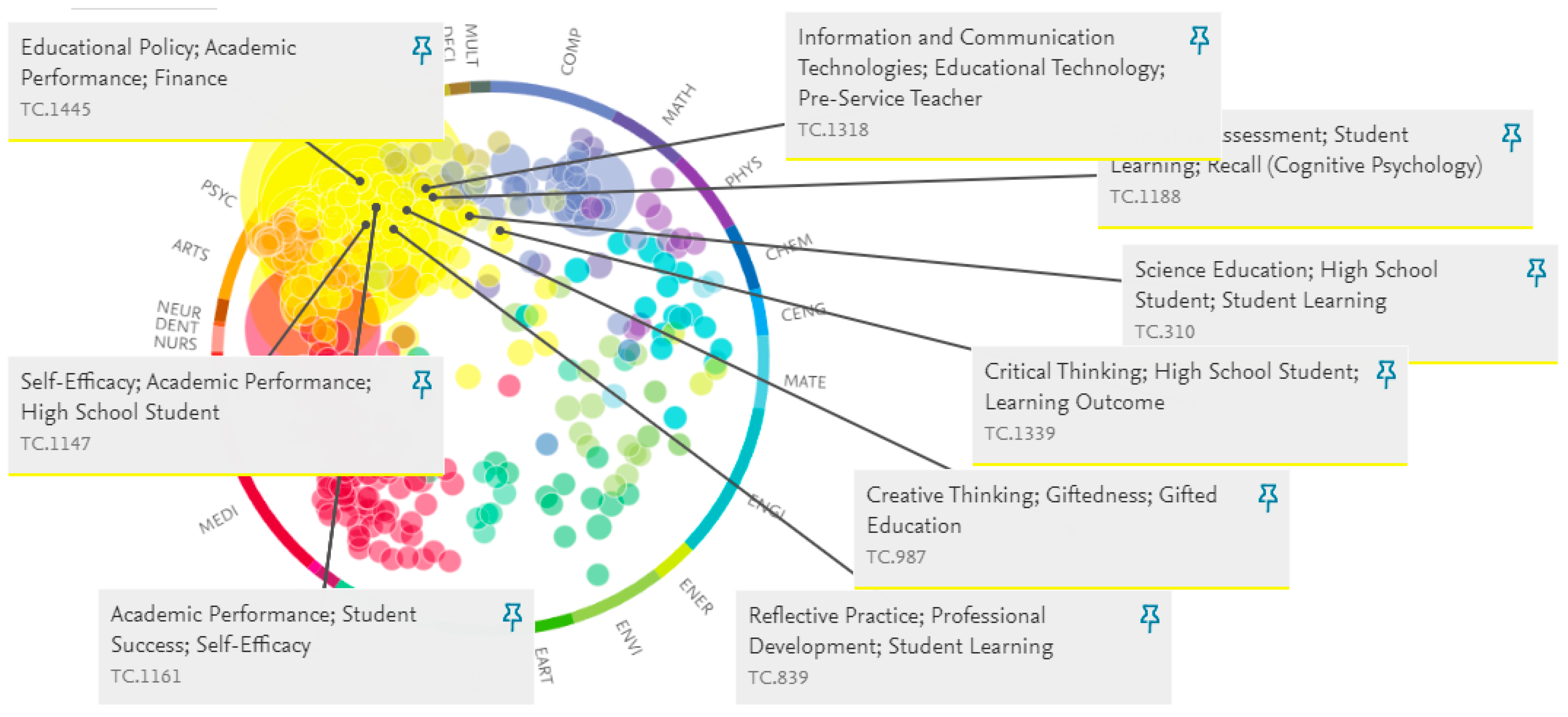
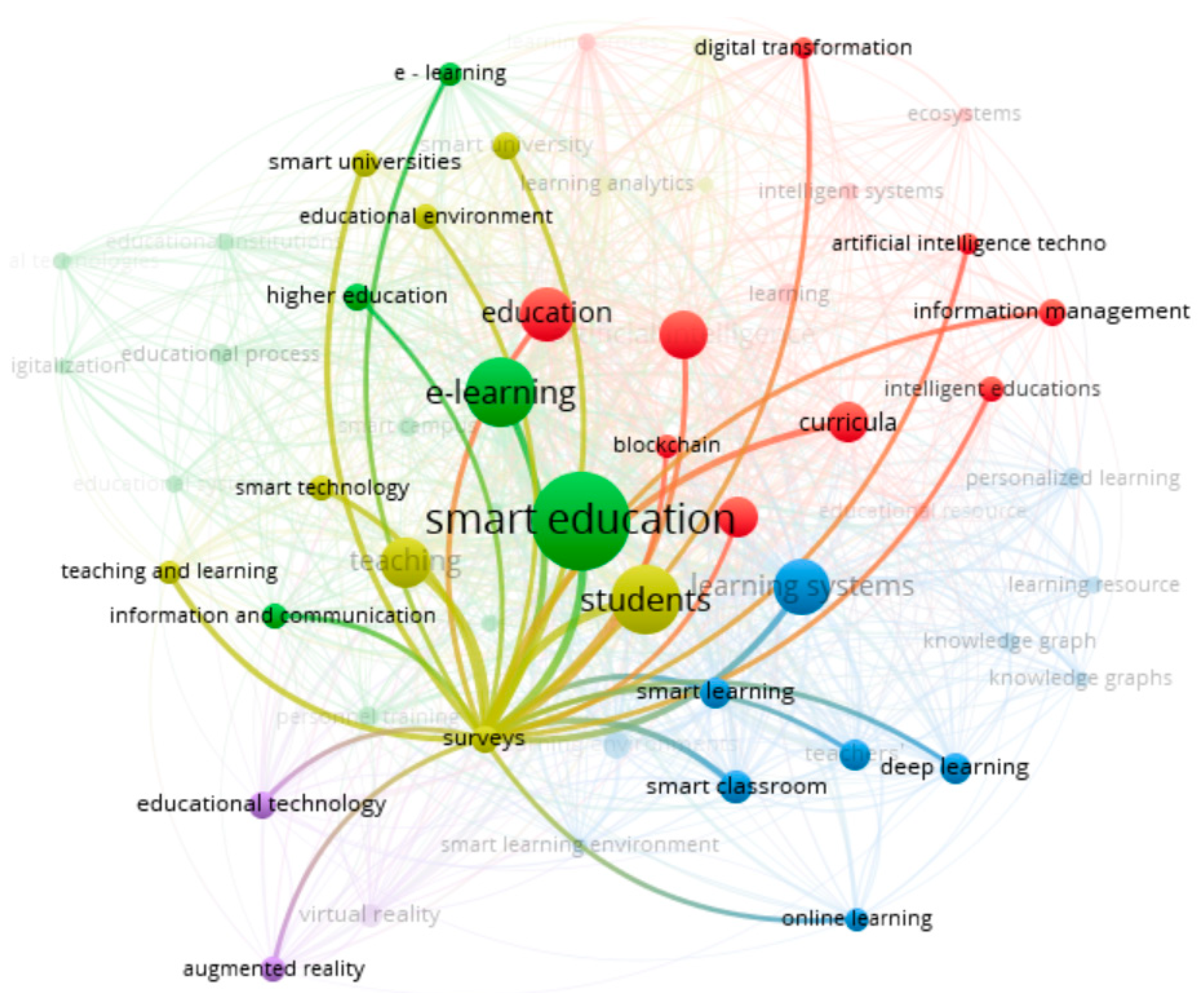


| Topic Cluster | Area | Prominence Percentile, Progress |
|---|---|---|
| Educational Policy; Academic Performance; Finance | Social Sciences; Economics, Econometrics, and Finance | 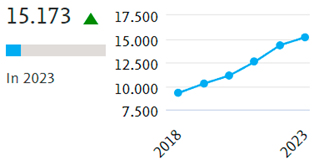 |
| Educational Policy; Education Research; Intergenerational Mobility | Social Sciences | 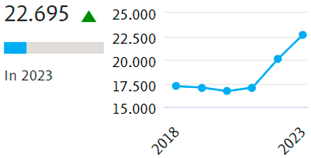 |
| Critical Thinking; High School Student; Learning Outcome | Social Sciences | 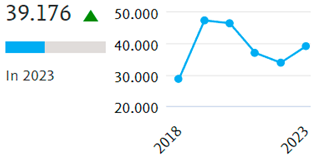 |
| Academic Performance; Student Success; Self-Efficacy | Social Sciences | 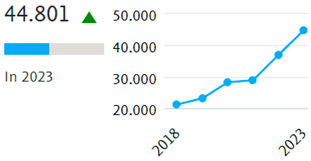 |
| Reflective Practice; Professional Development; Student Learning | Social Sciences; Psychology |  |
| Formative Assessment; Student Learning; Recall (Cognitive Psychology) | Social Sciences | 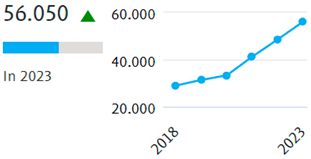 |
| Sustainable Development Goals; Industrial Sector; Student Learning | Social Sciences | 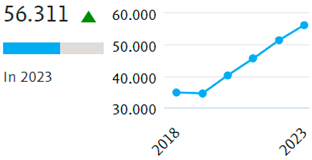 |
| Self-Efficacy; Academic Performance; High School Student | Social Sciences | 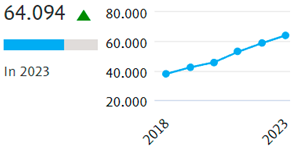 |
| Information and Communication Technologies; Educational Technology; Pre-Service Teacher | Social Sciences; Business, Management, and Accounting | 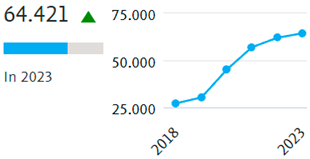 |
| Creative Thinking; Giftedness; Gifted Education | Social Sciences; |  |
| Science Education; High School Student; Student Learning | Social Sciences | 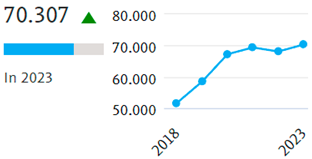 |
| Professional Development; Educational Policy; Pre-Service Teacher | Social Sciences | 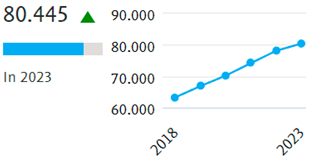 |
| No | University | Number of Respondents | Female | Male | Other |
|---|---|---|---|---|---|
| 1. | Karaganda University named after Academician Buketov | 73 | 43 | 29 | 1 |
| 2. | University of Economics and Innovation in Lublin (WSEI University) | 45 | 33 | 12 | 0 |
| 3. | National Louis University | 364 | 283 | 81 | 0 |
| 4. | Mieszko I University of Applied Sciences in Poznan | 56 | 17 | 39 | 0 |
| 5. | University of Economics in Bratislava | 61 | 27 | 34 | 0 |
| 6. | West Ukrainian National University | 118 | 86 | 31 | 1 |
| 7. | Taras Shevchenko National University of Kyiv | 144 | 88 | 54 | 2 |
| 8. | Ternopil National Pedagogical University named after V. Hnatyuk | 243 | 211 | 32 | 0 |
| Sum | 1104 | 788 | 312 | 4 |
| No | Parts | Content |
|---|---|---|
| 1. | Appeal to respondents | Dear Colleague, Please write down your answers in a simple questionnaire. It will take less than five minutes and help you understand your attitude toward artificial intelligence (AI). The interview is voluntary and anonymous. By answering questions, you are participating in the creation of a new future. Please click the blue “Zapisz Ankietę” button after the questionnaire. Thank you for your time. |
| 2. | Metrics (questions 1–4) | 1. Gender 2. Age 3. Study (degree) 4. Country |
| 3. | Body (12 questions from 5 to 16) | 5. How do you feel about artificial intelligence? 6. How do you feel about using artificial intelligence in the teaching process? (a central question) 7. How often do your professors use artificial intelligence in the teaching process? 8. How often do you need to use artificial intelligence in the learning process? 9. Multiple: In what situations do you use artificial intelligence during learning? 10. Do you think artificial intelligence threatens higher education in the next five years? 11. Do you think artificial intelligence is a threat for future generations? 12. Do you fear that using artificial intelligence in higher education will get out of control within the next five years? 13. How often do you use artificial intelligence in your learning process? 14. Will artificial intelligence replace university teachers in 5 years? 15. If artificial intelligence replaces university teachers, how would you feel about it? 16. Will you be happy if artificial intelligence replaces university teachers? |
| Group of Respondents | N | Definitely Positively | Rather Positively | Hard to Say | Rather Negatively | Definitely Negatively |
|---|---|---|---|---|---|---|
| 1. Kazakhstan | 72 | 9 | 22 | 18 | 11 | 12 |
| 2. Poland | 44 | 5 | 23 | 12 | 3 | 1 |
| 3. Poland | 364 | 71 | 156 | 82 | 43 | 12 |
| 4. Poland | 56 | 10 | 16 | 15 | 12 | 3 |
| 5. Slovakia | 61 | 27 | 24 | 7 | 3 | 0 |
| 6. Ukraine | 118 | 31 | 46 | 32 | 8 | 1 |
| 7. Ukraine | 144 | 30 | 55 | 25 | 26 | 8 |
| 8. Ukraine | 243 | 58 | 113 | 52 | 18 | 2 |
| Total | 1102 | 241 | 455 | 243 | 124 | 39 |
| Group of Respondents | N | M(x) | δx | δx−1 |
|---|---|---|---|---|
| 1. Kazakhstan | 72 | 31.94 | 46.62 | 46.95 |
| 2. Poland | 44 | 9.09 | 28.75 | 29.08 |
| 3. Poland | 364 | 15.11 | 35.81 | 35.86 |
| 4. Poland | 56 | 26.79 | 44.28 | 44.69 |
| 5. Slovakia | 61 | 4.92 | 21.62 | 21.80 |
| 6. Ukraine | 118 | 7.63 | 26.54 | 26.66 |
| 7. Ukraine | 144 | 23.61 | 42.47 | 42.62 |
| 8. Ukraine | 243 | 8.23 | 27.48 | 27.54 |
| Population | 1102 | 14.70 | 35.48 | 35.52 |
| Statistical Indicators | Value for Respondent Groups: | |||||||
|---|---|---|---|---|---|---|---|---|
| 1 | 2 | 3 | 4 | 5 | 6 | 7 | 8 | |
| Sample size, N | 72 | 44 | 364 | 56 | 61 | 118 | 144 | 243 |
| The average of the sample, M(x) | 31.94 | 9.09 | 15.11 | 26.79 | 4.92 | 7.63 | 23.61 | 8.23 |
| The standard deviation for the sample, δx | 46.62 | 28.75 | 35.81 | 44.28 | 21.62 | 26.54 | 42.47 | 27.48 |
| Average error, ṠẊ = δx/√n | 5.494 | 4.334 | 1.877 | 5.917 | 2.768 | 2.443 | 3.539 | 1.763 |
| Value |tstat| for μ0 = 0.00%, (M(x) − μ0)/ṠẊ | 5.813 | 2.097 | 8.050 | 4.528 | 1.777 | 3.123 | 6.671 | 4.669 |
| Value ttabl for the standard testing level of α (0.05) | 1.645 | 1.645 | 1.645 | 1.645 | 1.645 | 1.645 | 1.645 | 1.645 |
| |tstat| > ttabl | Yes | Yes | Yes | Yes | Yes | Yes | Yes | Yes |
Disclaimer/Publisher’s Note: The statements, opinions and data contained in all publications are solely those of the individual author(s) and contributor(s) and not of MDPI and/or the editor(s). MDPI and/or the editor(s) disclaim responsibility for any injury to people or property resulting from any ideas, methods, instructions or products referred to in the content. |
© 2024 by the authors. Licensee MDPI, Basel, Switzerland. This article is an open access article distributed under the terms and conditions of the Creative Commons Attribution (CC BY) license (https://creativecommons.org/licenses/by/4.0/).
Share and Cite
Okulich-Kazarin, V.; Artyukhov, A.; Skowron, Ł.; Artyukhova, N.; Wołowiec, T. When Artificial Intelligence Tools Meet “Non-Violent” Learning Environments (SDG 4.3): Crossroads with Smart Education. Sustainability 2024, 16, 7695. https://doi.org/10.3390/su16177695
Okulich-Kazarin V, Artyukhov A, Skowron Ł, Artyukhova N, Wołowiec T. When Artificial Intelligence Tools Meet “Non-Violent” Learning Environments (SDG 4.3): Crossroads with Smart Education. Sustainability. 2024; 16(17):7695. https://doi.org/10.3390/su16177695
Chicago/Turabian StyleOkulich-Kazarin, Valery, Artem Artyukhov, Łukasz Skowron, Nadiia Artyukhova, and Tomasz Wołowiec. 2024. "When Artificial Intelligence Tools Meet “Non-Violent” Learning Environments (SDG 4.3): Crossroads with Smart Education" Sustainability 16, no. 17: 7695. https://doi.org/10.3390/su16177695






